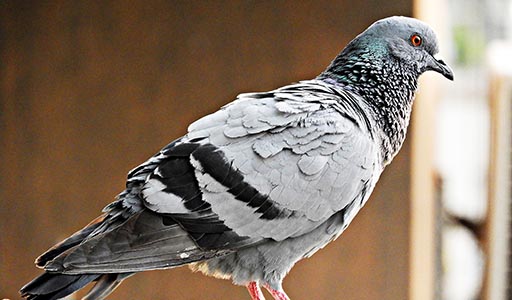Pigeons

Pigeon Information
If you’ve ever traveled to New York City, you’re all too familiar with pigeons. Pigeons are grey birds that feed primarily on grains and seeds, as well as any food fed to them by humans. Pigeons inhabit many of the world’s large cities, possibly even your own. As social birds, pigeons are often found in groups or flocks. Pigeons can cause disruption on your property when they are searching for nesting sites. There is even a fear of the transmission of disease from pigeon droppings. Besides being a danger in the air, the droppings left by gulls may contain acid that can destroy the materials used to build your house like wood and metal.

What does a Pigeon look like?
The appearance of pigeons varies a great deal. Seed-eating species tend to have neutral-colored beaks, gray feathers, white backsides, and black stripes on their wings and tails. On the other hand, primarily fruit-eating varieties often display bright-colored feathers and orange beaks. On average, pigeons are about a foot long and weigh around 13 ounces.

What does a Pigeon eat?
Pigeons pluck seeds from the ground and eat fruit straight from trees. In fact, large flocks often work together to pick an area clean. Big, easy-to-reach fruit is left for larger pigeons, while the smaller birds stick to tiny, hard-to-reach items. During times when food is scarce, the pests also feed on flowers, as well as snails, lizards, and insects.

Pigeon habitats
Pigeons can be found in deserts, forests, and urban habitats alike. The only places they’re not seen are those that experience extreme, arctic cold. These highly adaptable birds are known for scavenging scraps from the ground or garbage cans in big cities, where their populations can grow quite large. However, they’re also a major nuisance for farmers in rural areas, causing inventory loss and contamination issues when they gather around grain elevators and mills.
Frequently Asked Questions
The male chooses the nesting site, bringing straw and other items to the female to make the roost. A pigeon nest starts as a loose platform of sticks and twigs. Even if trapped and displaced, a pair of pigeons will return to the same nesting area again and again.
Unlike other birds, pigeons don’t clear away waste from their nestlings while in the roost. Instead, droppings in the pigeon nest mix with twigs, straw, and unhatched or broken eggs. This makes the structure sturdier and more foul-smelling over time.
The three most common Columbidae pigeon and dove species in North America are:
Rock Pigeon – Probably the most well-known city dweller in the U.S., these birds are found almost everywhere. They are gray with reddish-purple feet and have two black bands on their wings as well as a green iridescent throat.
Eurasian Collared Dove – Most often confused with the rock pigeon, this species is found across the U.S. except in the northeastern states. Usually grey or light brown, these birds have a long tail and a distinct black crescent collar on the back of the neck.
Mourning Dove – Named for its sad, haunting call, these birds are rarely found in deep woods, preferring open fields or a perch on a telephone wire. With their tawny feathers, black-spotted wings, and white-tipped tail feathers, these doves blend in perfectly with their surroundings.
One key way to tell the difference between a pigeon vs. a dove is size. Of the three species listed above, rock pigeons are the largest, with an average weight of 13.5 ounces. Mourning doves are the smallest, weighing only about 4.5 ounces.

